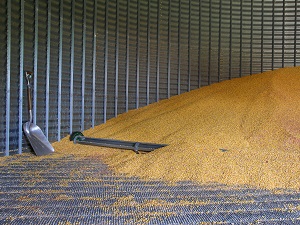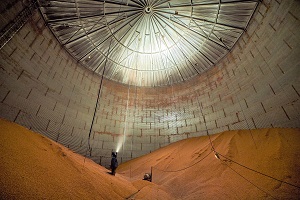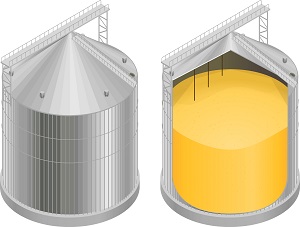Suffocation is a leading cause of death in grain storage bins. Suffocation can occur when a worker becomes buried (engulfed) by grain as they walk on moving grain or attempt to clear grain built up on the inside.

Moving grain acts like "quicksand" and can bury a worker in seconds. "Bridged" grain and vertical piles of stored grain can also collapse unexpectedly if a worker stands on or near it. The behavior and weight of the grain make it extremely difficult for a worker to get out of it without assistance.
OSHA Standard 1910.272(g)(1)(iv) "Walking down grain" and similar practices where an employee walks on grain to make it flow within or out from a grain storage structure, or where an employee is on moving grain, are prohibited.
Wet weather conditions increase the risk of engulfment for workers inside grain bins. Moisture content causes grain to bridge or clump together. Workers who step onto the bridge to loosen grain from side walls can be buried if the bridge collapses or causes an avalanche under the worker’s weight.
Grain bins can develop hazardous atmospheres or a lack of oxygen. Workers should not enter grain storage bins unless it is absolutely necessary.
All grain facility workers must be trained for the specific hazardous work operations they are to perform when entering and working inside of grain bins. Workers under 16 years old are prohibited from entering grain bins.

Never walk on the grain to make it flow. Do not enter onto or below bridged grain or when grain is built up on the sides. Use a rod or vibration system to break up clumped grain from a safe location outside of the bin.
Provide workers with body harnesses that have an attached lifeline and other rescue equipment (like winch systems) along with the training to ensure the equipment is used properly. Ensure that the lifeline is positioned and of sufficient length to prevent a worker from sinking further than waist-deep in grain.
Disconnect, lockout, and tagout machinery, and block-off all powered equipment, especially grain moving equipment (like augers). Grain must never be emptied or moved into or out of the bin while workers are inside because it creates a suction that can pull them into the grain in seconds.
Test the air within a bin or silo prior to entry for the presence of combustible and toxic gases, and to determine if there is sufficient oxygen. If detected by testing, vent hazardous atmospheres to ensure that combustible and toxic gas levels are reduced to non-hazardous levels, and that sufficient oxygen levels are maintained. If toxicity or oxygen deficiency cannot be eliminated, workers must wear appropriate respirators.
A rescue-trained observer should be stationed outside who is in constant contact (visual, voice, or signal line) with all workers in the bin.
Issue a permit each time a worker enters a bin, unless the employer is present during the entire entry operation. The permit must certify that all safety precautions have been implemented before workers enter the bin.

Storage structures can develop hazardous atmospheres due to gases given off from spoiling grain or fumigation. Workers may be exposed to unhealthy levels of airborne contaminants including molds, chemical fumigants (toxic chemicals), and gases associated with decaying and fermenting silage.
OSHA Standard 1910.272(g)(1)(iii) The atmosphere within a bin, silo, or tank shall be tested for the presence of combustible gases, vapors, and toxic agents when there is reason to believe they may be present. (A) Ventilation shall be provided until the unsafe condition or conditions are eliminated. (B) If toxicity or oxygen deficiency cannot be eliminated by ventilation, employees entering the bin, silo, or tank shall wear an appropriate respirator.
Fumigants are commonly used for insect control on stored grain, and many have inadequate warning properties. Exposure to fumigants may cause permanent central nervous system damage, heart and vascular disease, and lung edema as well as cancer. These gases may result in a worker passing out and falling into the grain, and then becoming engulfed and suffocating or otherwise injuring themselves.

Incidents in grain bins often result in multiple deaths because other workers attempt to rescue their co-workers and become trapped or overcome as well.
Pulling out a worker who is trapped in a grain bin requires a great deal of force, much more than is needed to rescue someone from under water. Water has “buoyancy,” which “floats” ships and helps lifeguards rescue victims much larger than themselves. Grain does not have buoyant properties and resists the force a rescuer uses when trying to remove a buried worker.
OSHA Standard 1910.272(g)(4) The employer shall provide equipment for rescue operations which is specifically suited for the bin, silo, or tank being entered.
Rescue systems should be designed and built to overcome the resistance of the grain because a rescuer’s strength alone is not likely to be enough to rescue a trapped worker.

.jpeg)

